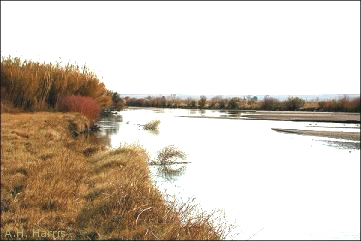

High in the mountains of Colorado, winter snows slowly melt under the Spring sun, and a gurgling finger of water emerges from the skirts of a snow bank. As the infant stream yields to gravity's pull, other waters fall in behind, like the fabled rodents following the pied piper of Hamelin. The Rio Grande is thus born, destined to alternate between rambunctiousness and serenity on its trip to the Gulf of Mexico.
But, as with many a traveler setting out on a long journey, the
intended destination may never be reached. Entering the lower lands of New Mexico,
irrigation steals from the strength of the river. Then, impounded behind dams in the
northern reaches of the Chihuahuan Desert, evaporation does its magic. Finally released
from its bonds, the diminished, though still respectable, river wends southward, only
to bleed its waters into a thousand veins for the fields of southern New Mexico and the
borderland of Texas and Mexico. Alas, in most years, the journey ends with a whimper
downstream from El Paso in a grave of salt-encrusted mud.

Contributor: Arthur H. Harris, Laboratory for Environmental Biology, Centennial Museum, University of Texas at El Paso.
Desert Diary is a joint production of the Centennial Museum and KTEP National Public Radio at the University of Texas at El Paso.

Rio Grande near Canutillo, Texas. Photograph by A.H. Harris.